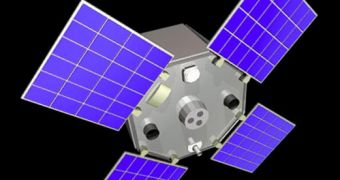NASA's Active Cavity Radiometer Irradiance Monitor Satellite (AcrimSat) has just turned ten, experts with the space agency are proud to announce. During its long-term mission, the instrument was able to conduct very precise and complex measurements of the total amount of energy our Sun was producing, and will most likely continue to do so for the foreseeable future. The dedicated satellite is also one of 21 primary observational components of the Earth Observing System program, conducted by NASA in cooperation with JAXA. It was launched in 1999 from the Vandenberg Air Force Base (VAFB).
It's science mission officially began in April 2000, after the satellite passed its commissioning and testing phases. Since then, it has been measuring the TSI (Total Solar Irradiance) with what were, at the time of its launch, state-of-the-art capabilities. Its databases are merged with those created by its predecessors, the Solar Maximum Mission (ACRIM1: 1980-1989) and the Upper Atmosphere Research Satellite (ACRIM2: 1991-2001). The new observatory's main scientific payload is the ACRIM III instrument, experts at the Jet Propulsion Laboratory (JPL) say.
AcrimSat “was the first [satellite] to clearly demonstrate that the total radiant energy from the Sun was not a constant. However, the solar variability was so slight (0.1% of full scale) that continuous monitoring by state-of-the-art instrumentation was necessary. It is theorized that as much as 25% of the anticipated global warming of the earth may be solar in origin. In addition, seemingly small (0.5%) changes in the TSI output of the sun over a century or more may cause significant climatological changes on Earth,” the mission's main page says.
The principal investigator for the ACRIM mission is Dr. Richard Willson, a scientist at the Columbia University. JPL scientist Roger Helizon is the ACRIM project manager and instrument scientist. The mission is being controlled via the CRIM tracking station at the JPL Table Mountain Observatory.
The Orbital Sciences Corporation (OSC)-built spacecraft was funded by NASA through the Earth Science Programs Office, based at the Goddard Space Flight Center, in Greenbelt, Maryland. Experts say it is an example of the efficacy underlying NASA's “Better, Faster, Cheaper” initiative. All things associated with the mission, including the satellite itself, the launch, tracking facilities, data handling and science team activities were completed with only $30 million.
“By measuring incoming solar radiation, climatologists are using AcrimSat to improve their predictions of climate change and global warming over the next century,” the JPL team adds. The satellite took off from the VAFB on December 20, 1990, aboard a Taurus rocket. It was a secondary payload, with the primary one being KOMSAT, a Korea Aerospace Research Institute-built satellite. AcrimSat is currently located in a 700-kilometer, Sun-synchronous orbit.

 14 DAY TRIAL //
14 DAY TRIAL //